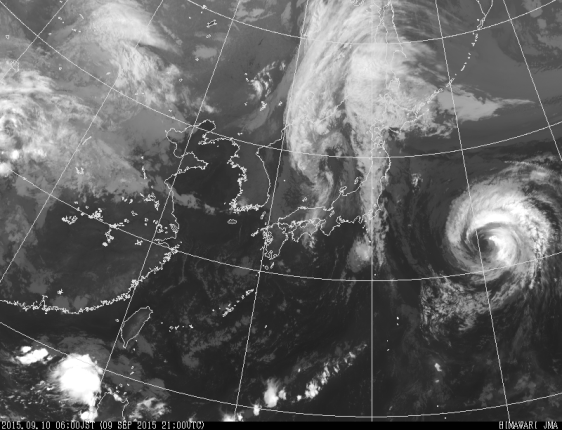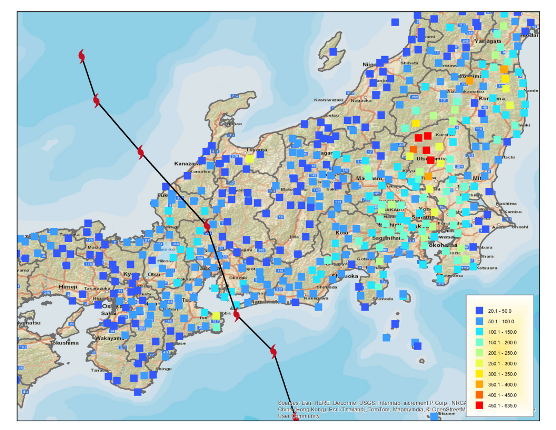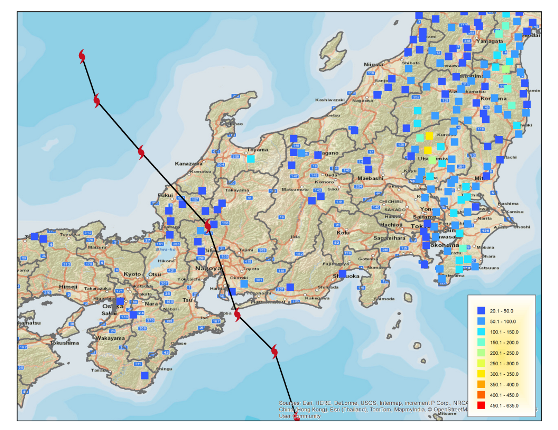Japan Flood Typhoon Etau
Status: Closed
| Type of posting | Posting date(EST): | Summary | Downloads |
|---|---|---|---|
| First Posting | 9/11/2015 8:00:00 AM |
|
First Posting | Summary
Posting Date: September 11, 2015, 8:00:00 AM
Torrential rainfall in Japan during the last three days—exacerbated by Typhoon Etau—has resulted in significant flooding in areas north and east of Tokyo, with tremendous levels of damage to property and infrastructure, and widespread evacuations. Some deaths and injuries have resulted from the devastating flooding, and a number of people have been reported missing.
Typhoon Etau, which made landfall in the morning local time on Wednesday, September 9, on the Chita Peninsula of Aichi Prefecture, underwent extratropical transition as it passed over Honshu. Etau (referred to as Typhoon No. 18 in Japan) exited Honshu into the Sea of Japan later Wednesday, and that evening became a post-tropical low-pressure system.
Approximately 860,000 people north and east of Tokyo were advised to evacuate, with approximately 100,000 people ordered from their homes.
Meteorological Summary
Typhoon Etau made landfall in Aichi prefecture on the island of Honshu, Japan, around 00 UTC September 9, at which time the Japan Meteorological Agency (JMA) estimated a minimum central pressure of 990 mb and a maximum 10-minute sustained wind speed of 45 knots (~60 mph 1-minute sustained). At the time of landfall, Etau was nearly devoid of strong convection near its center, and it already was beginning to exhibit extratropical characteristics (see Figure 1), including an elongated, comma-shaped cloud presentation. After landfall, Etau tracked generally to the northwest, with JMA indicating that Etau lost tropical characteristics at 12 UTC September 9 over the Sea of Japan.

Figure 1. Visible satellite image valid at the time of Typhoon Etau landfall, 00 UTC September 9. (Source: JMA)
Etau did not cause significant damage near the landfall location from wind or precipitation, but it has produced prodigious rainfall and flooding several hundred kilometers to the east of where it tracked across Honshu. After completing extratropical transition, the remnants of Etau produced very heavy rainfall to the north of Tokyo, as indicated by Figure 2, in a distinctive north-south oriented band, which was likely enhanced by a pre-existing stationary front.

Figure 2. Visible satellite image of Typhoon Etau valid at 21 UTC September 9. Tropical Cyclone Kilo is also evident to the east of Japan. (Source: JMA)
Portions of Tochigi prefecture received up to 635 mm of rainfall in the 48-hour period ending at 13 UTC September 10 (see Figure 3), with a large fraction of that rainfall occurring in the past 24 hours, well after Etau had lost tropical characteristics (see Figure 4). 
Figure 3. Typhoon Etau track from the JMA (black line) and 48-hour rainfall totals (mm) ending at 13 UTC 10 September. (Source: JMA)

Figure 4. Typhoon Etau track from the JMA (black line) and 24-hour rainfall totals (mm) ending at 13 UTC 10 September. (Source: JMA)
Reported Damage and Disruption
The nearly unprecedented precipitation— some areas of Honshu received twice their normal September rainfall in just 48 hours—has caused rivers to burst their banks and at least one levee to fail, resulting in numerous landslides and mudslides and widespread flooding in Ibaraki and Tochigi prefectures. Boats and helicopters have been employed throughout the region to rescue stranded people, many from the roofs of flooded buildings. At least two deaths have been reported, and many more people have been injured; in addition, a number of people have been reported missing.
Damage from the devastating flooding has resulted from myriad impacts, from houses submerged or swept off their foundations and vehicles engulfed and overturned, to uprooted trees. The heavy flooding also has overwhelmed the drainage pumps for the crippled Fukushima Daiichi nuclear power plant in Fukushima Prefecture, resulting in leaks of hundreds of tons of radioactive water into the Pacific Ocean.
The heavy rain, as well as the wind from Typhoon Etau, prompted the cancellation of dozens of commercial airline flights and the suspension of some train service.
Exposure at Risk
The vulnerability of buildings to flood damage varies by construction type. For a given flood depth, a residential wood-frame building is expected to sustain more damage than a residential masonry building. Concrete construction is less vulnerable to flood than steel or masonry. Commercial and apartment buildings usually have stronger foundations than residential buildings, and are thus better able to resist flood loads.
Building height also affects flood damage. Because damage is usually limited to the lower stories of a building, high-rise buildings will experience a lower damage ratio—the repair cost compared to the total replacement value of the building—than low-rise buildings because a smaller proportion of the building is affected.
Water damage to machinery and contents drives most flood-related loss. Although wind damage is typically automatically covered under standard fire insurance policies in Japan, flood damage is not, despite the fact that Japan regularly experiences “wet” storms that deliver extreme precipitation and flooding that contribute substantially to damage. Property owners who want flood coverage can purchase it as an add-on to a standard policy or they can select a comprehensive policy, but take-up rates for flood are relatively low.